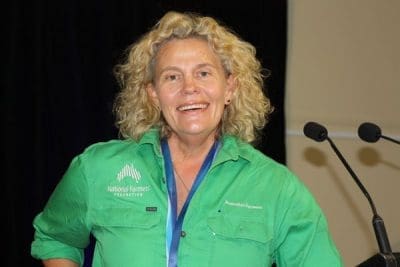THE National Farmers Federation is looking at a change to its structure which better enables it to fulfil its role as agriculture’s national advocacy group in a world where social media demands immediacy.

Fiona Simson
Speaking at Beef 2018, NFF president, Fiona Simson, said NFF had 37 state and commodity-based member bodies, and the structure has proved effective since the organisation’s inception in 1979.
However pressure on the NFF to be able to respond quickly to issues in the national spotlight meant the need for a revamped structure would be assessed as part of Talking 2030, which aims to make Australian agriculture a $100-billion industry by 2030.
“Is it the right model as we head towards the future?” she asked.
Mrs Simson said resolutions and motions, as a hallmark of the current structure, did not provide the immediacy an agricultural advocacy group needed.
“Now we can’t wait for that to happen. Advocacy is immediate. People will start building pressure for something to happen.”
“Social media is an environment where people can make their voices heard and that can make difference with politics.”
Mrs Simson said the recent distressing footage of live-export sheep was a prime example of the need for immediate advocacy.
“The internet now has made it possible for everybody to be a keyboard warrior…and our model doesn’t necessary help us the best way it can.”
Fix, not ban
Mrs Simson said cessation of live sheep exports would take $150 million out of the Western Australian economy alone, and while some stock could be processed, a glut of sheep would impact values.
“All that extra stock in that market would be devastating.”
She said industry was anxiously awaiting the findings of the upcoming McCallum report, and that NFF already recognised the need for improvements in some areas of live export.
“We have the view we need to fix it, not ban it.”
Extra $19 billion
Talking 2030 aims to turn Australian agriculture into a $100 billion industry by 2030 from a $63b dollar one at present.
Mrs Simson said forecast CPI growth alone would add $19b to agriculture’s earnings by 2030, and the challenge lay in how to get the remaining $18b on to the books.
“At the moment, it’s $63b, up 14 percent on last year. It’s an industry I think is going to underpin Australian growth in the future.”
She said agriculture was Australia’s fastest-growing industry last year, and has experienced exceptional growth in recent years.
Material evidence
Mrs Simson said the NFF was enjoying a high profile in Canberra because of its ability to put forward evidence-based material on issues such as the backpacker tax.
She also said its effectiveness was assisted by its committees being made up of producers and people who worked for member organisations.
NFF has embarked on its e-advocacy program through www.ausfarmers.org.au, which Mrs Simson said enabled people outside agriculture to learn about sectors and issues via facts and figures from across Australia.
“They can read about it in a slightly warmer and fuzzier way.”
Connectivity lacking
As part also of a family cropping and cattle business on the Liverpool Plains of northwest New South Wales, Mrs Simson said digital agriculture was “incredibly exciting”, but improved connectivity was a must.
“Rural development corporations across Australia have come together in a ground-breaking program called Precision to Decision.
“That project established that the benefit to agriculture is in order of $20b, but one of the things holding ag back is basic connectivity.”
Growing different crops, or current crops in different ways or new areas, could also provide big productivity boosts to Australian agriculture, she said.
Brands and insurance
Mrs Simson said Australian agricultural products were hard to identify overseas, and a national brand like New Zealand’s fern could boost sales and profile.
“Looking at branding of Australian product is one of the things we’ve been talking about.”
Income insurance for producers, and the way in which government policy to support growers impacted by seasonal conditions would be affected by private policies, is also being looked at as part of Talking 2030.
“NFF is keenly looking at that space and… what it would mean to government is that they would pull back from that space.”
Mrs Simson said while natural disaster funding would be likely to continue, and income protection covering crops and livestock could call for cooperative support or government subsidisation as occurs in some other countries.
“Talks are still continuing, and it’s important we have them,” she said.
Policies would need to be more affordable than some that were already on the market to protect against adverse weather and other factors.
- Talking 2030 was launched in March and will consolidate feedback from round-table discussions held at 13 sites across Australia to form a strategy based on its themes of global markets, workforce, farm business, environment, and infrastructure.
